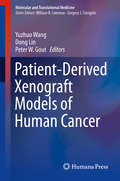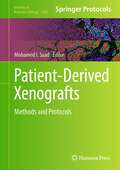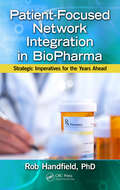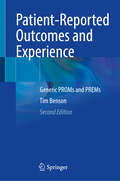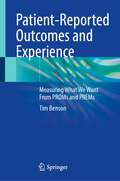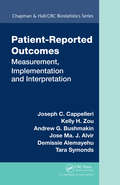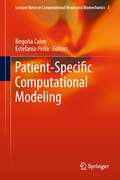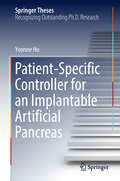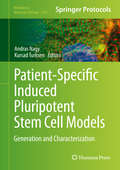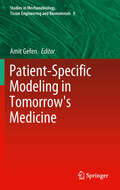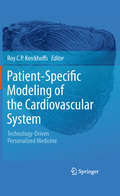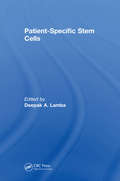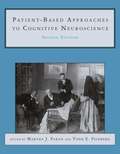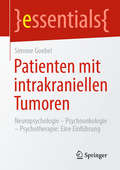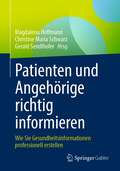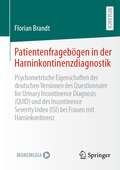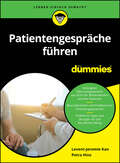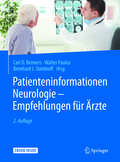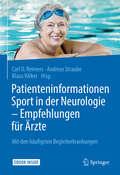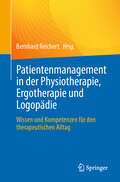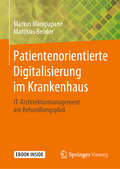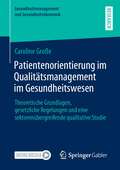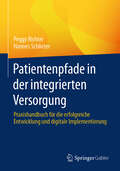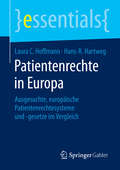- Table View
- List View
Patient-Derived Xenograft Models of Human Cancer
by Dong Lin Yuzhuo Wang Peter W. GoutThis book provides a comprehensive, state-of-the-art review of PDX cancer models. In separately produced chapters, the history and evolution of PDX models is reviewed, methods of PDX model development are compared in detail, characteristics of available established models are presented, current applications are summarized and new perspectives about use of PDX models are proposed. Each chapter is written by a world-renowned expert who is conducting cutting-edge research in the field. Each of the subsections provide a comprehensive review of existing literature addressing the particular topic followed by a conclusive paragraph detailing future directions. Extensive illustrations make this an interactive text. Patient-Derived Xenograft Models of Human Cancer will serve as a highly useful resource for researchers and clinicians dealing with, or interested in, this important topic. It will provide a concise yet comprehensive summary of the current status of the field that will help guide preclinical and clinical applications as well as stimulate investigative efforts. This book will propagate innovative concepts and prompt the development of ground-breaking technological solutions in this field.
Patient-Derived Xenografts: Methods and Protocols (Methods in Molecular Biology #2806)
by Mohamed I. SaadThis detailed volume explores the dynamic landscape of patient-derived xenograft (PDX) generation and applications. After a few chapters examining the evolution of PDXs, tracing their roots and contextualizing their significance in the broader narrative of cancer research, the book continues with methodologies for generating PDXs from diverse clinical tissue samples as well as for utilizing PDXs in various specific cancer types. From the development of humanized PDX models to the exploration of protein expression through advanced techniques including multiplex immunohistochemistry, Western blotting, and immunoprecipitation, the chapters offer a comprehensive toolkit for researchers and clinicians alike. Written for the highly successful Methods in Molecular Biology series, chapters include introductions to their respective topics, lists of the necessary materials and reagents, step-by-step and readily reproducible laboratory protocols, and tips on troubleshooting and avoiding known pitfalls. Authoritative and practical, Patient-Derived Xenografts: Methods and Protocols serves as an ideal interdisciplinary guide for understanding the intricate processes that underscore translational cancer research.
Patient-Focused Network Integration in BioPharma: Strategic Imperatives for the Years Ahead
by Robert HandfieldThe biopharmaceutical industry as we know it today is going through a massive upheaval as a result of the uncertainty of healthcare reform and increasing regulatory pricing pressure. A wake-up call to all sectors of the healthcare value chain, Patient-Focused Network Integration in BioPharma: Strategic Imperatives for the Years Ahead explores patient-focused network integration as quite possibly the only way for organizational evolution to occur. The book discusses how to align enterprises with the patient at the center. It details the historical context of the biopharmaceutical value chain and the current set of challenges facing the industry, and then details the author’s unique and sustainable agenda for change.The book traces the critical but often ignored relationships between hospitals, insurance companies, biopharma manufacturers, government regulators, and clinical scientists. For too long, these parties have been operating in a void, without recognizing the interconnectedness of their objectives, even though these objectives are often competing and misaligned. This book points out the gaps that exist and develops a set of recommendations regarding disease treatments, clinical development of new products, and collaboration between these players that can result in a sustainable solution to the healthcare mess. Each chapter can be viewed as an independent essay, in that it deals with a specific dimension of the healthcare value chain. However, together they provide an integrated discussion on how to begin the task of creating an integrated value chain network for healthcare. The book begins with the patient, and then works its way back down the value chain, all the way to the drug development and clinical trials stage of the value chain. The common thread throughout the chapters is the emphasis on collaboration, strategic alignment, and a focus on delivering value to the end patient.Very simply, all parties in the healthcare value chain network must align their strategic planning to derive innovation solutions. It is only through true collaboration and aligned thinking that the parties in the drug development, distribution, insurance payors, and hospital provider network can deal with the incredible complexity and massive challenges that face the industry. The book provides a compelling maturity model that enables readers to gauge the level of network integration their enterprise is at today, and where they need to move in the future.
Patient-Reported Outcomes and Experience: Generic PROMs and PREMs
by Tim BensonThis revised edition shows how patient-reported outcome models (PROMs) and patient-reported experience models (PREMs) can help improve health outcomes and patient experience. The first section covers the core principles of PROMs and PREMs, including their strengths and weaknesses, reporting and analysis, while the second section covers measures of patient experience, health status, wellbeing, self-efficacy, individualized measures, social determinants of health, and impact evaluation. The final section covers topics such as noise, interoperability and quality-adjusted life years. Patient-Reported Outcomes and Experience: Generic PROMs and PREMs covers how to use these measures to improve the outcomes of healthcare services and associated patient experience. It is a critical resource for clinicians, managers, analysts and policymakers seeking an up-to-date reference on the latest developments in this rapidly expanding field.
Patient-Reported Outcomes and Experience: Measuring What We Want From PROMs and PREMs
by Tim BensonThis book shows how PROMs and PREMs can help improve patient experience and outcomes. Part 1 covers the core principles of PROMs and PREMs, including their strengths and weaknesses, reporting and analysis, data sharing and valuation. Part 2 covers measures of patient experience, health status, wellbeing, self-efficacy, individualized measures, social determinants of health and impact evaluation. It concludes with a discussion of staff-reported measures, proxies and caregivers. Patient-Reported Outcomes and Experience: Measuring What We Want with PROMs and PREMs concisely covers how to use these measures successfully to improve patient experience of healthcare services and associated outcomes. It is a critical resource for trainee and practicing clinicians, managers, analysts and policymakers seeking an up-to-date reference on the latest developments in this rapidly expanding field.
Patient-Reported Outcomes: Measurement, Implementation and Interpretation (Chapman & Hall/CRC Biostatistics Series)
by Joseph C. Cappelleri Demissie Alemayehu Kelly H. Zou Andrew G. Bushmakin Jose Ma. Alvir Tara SymondsHowever, exciting new developments are on the verge of changing the treatment of this debilitating disorder. Two anabolic agents, the parathyroid hormone (PTH) and the fluoride ion, show tremendous promise as tools for building and retaining bone - with no adverse side effects. Anabolic Treatments for Osteoporosis is a comprehensive account of the latest studies that have been carried out on these two agents, and a thorough assessment of their prospects as osteoporosis therapeutics. This unique book combines basic science and up-to-date clinical data to present a complete picture of this breakthrough in the treatment of a globally significant health issue.
Patient-Specific Computational Modeling
by Begoña Calvo Lopez Estefanía PeñaThis book addresses patient-specific modeling. It integrates computational modeling, experimental procedures, imagine clinical segmentation and mesh generation with the finite element method (FEM) to solve problems in computational biomedicine and bioengineering. Specific areas of interest include cardiovascular problems, ocular and muscular systems and soft tissue modeling. Patient-specific modeling has been the subject of serious research over the last seven years and interest in the area is continually growing and this area is expected to further develop in the near future.
Patient-Specific Controller for an Implantable Artificial Pancreas (Springer Theses)
by Yvonne HoThe thesis focuses on the control of blood glucose devices and design of implantable devices, and offers valuable insights on diabetes mellitus and related physiology and treatments. Diabetes mellitus is a widespread chronic disease in the modern world that affects millions of people around the globe. In Singapore, one in ten of the population has diabetes, and the severity of the problem has prompted the country’s prime minister to talk about the disease at the National Day Rally in 2017. Designing an artificial pancreas that can provide effective blood glucose control for individuals with diabetes is one of the most challenging engineering problems. The author reports on research into the development of an implantable artificial pancreas that can regulate blood glucose levels by delivering appropriate dosages of insulin when necessary. By sensing blood glucose and injecting insulin directly into the vein, the implantable device aims to remove delays that occur with subcutaneous blood glucose sensing and insulin delivery. Preliminary in-vitro and in-vivo experimental results suggest that the implantable device for blood glucose control could be a clinically viable alternative to pancreas transplant.
Patient-Specific Induced Pluripotent Stem Cell Models
by Kursad Turksen Andras NagyThis volume captures the rapid developments in the field of induced pluripotent stem (iPS) cells, which have provided novel opportunities and approaches both for better understanding a number of human diseases and for developing new platforms for drug development and screening for such diseases. Specifically, representative protocols on various disease models have been collected from labs around the world. Written for the highly successful Methods in Molecular Biology series, chapters include introductions to their respective topics, lists of the necessary materials and reagents, step-by-step, readily reproducible laboratory protocols, and tips on troubleshooting and avoiding known pitfalls. Authoritative and practical, Patient-Specific Induced Pluripotent Stem Cell Models: Generation and Characterization is an ideal reference for scientists working on furthering iPS research.
Patient-Specific Modeling in Tomorrow's Medicine
by Amit GefenThis book reviews the frontier of research and clinical applications of Patient Specific Modeling, and provides a state-of-the-art update as well as perspectives on future directions in this exciting field. The book is useful for medical physicists, biomedical engineers and other engineers who are interested in the science and technology aspects of Patient Specific Modeling, as well as for radiologists and other medical specialists who wish to be updated about the state of implementation.
Patient-Specific Modeling of the Cardiovascular System
by Roy C.P. KerckhoffsThe main purpose of the book is to demonstrate the design of a variety of patient-specific models within the cardiovascular system in computational biology. The maturation of computational biology could lead to a new approach to medicine. During the last five to ten years, there have been many improvements in diagnostic medical technologies such as multi-slice cardiac CT imaging, 3-D electroanatomic mapping, and many types of applications of Magnetic Resonance Imaging (i.e. magnetic resonance tagging and diffusion tensor imaging). Combined with more powerful computing resources and more accurate predictive computational models it is feasible to begin developing mechanistic patient-specific models that may help diagnosis, guide therapy or surgery, and predict outcomes of the latter. Many questions need to be answered before computational modeling can be fully integrated with standard care, such as what is the minimal data set needed from the patient in order to build a reliable predictive model? What accuracy is needed? How will the initial baseline model be validated? What are reasonable computation times? Is some type of perturbation of the patient's physiology necessary? How could they be integrated with current practices? Are physicians willing to accept these models? These questions will also serve as guidelines throughout the chapters. The book will try to cover, such as cardiac electrophysiology, cardiac (muscle) mechanics, circulation dynamics, arterial and venous flow, angiogenesis, remodeling, metabolism, or combinations between these such as cardiac electromechanics or fluid-solid interactions.
Patient-Specific Stem Cells
by Deepak A. LambaOne of the biggest challenges faced in medical research had been to create accurate and relevant models of human disease. A number of good animal models have been developed to understand the pathophysiology. However, not all of them reflect the human disorder, a classic case being Usher’s syndrome where the mutant mice do not have the same visual and auditory defects that patients face. There are others which have been even more difficult to model due to the multi-factorial nature of the condition and due to lack of discovery of a single causative gene such as age-related macular degeneration or Alzheimer’s syndrome. Thus a more relevant and accurate system will allow us to make better predictions on relevant therapeutic approaches. <P><P>The discovery of human pluripotent stem cells in 1998 followed by the technological advances to reprogram somatic cells to pluripotent-stem cell-like cells in 2006 has completely revolutionized the way we can now think about modelling human development and disease. This now coupled with genome editing technologies such as TALENS and CRISPRs have now set us up to develop in vitro models both 2D as well as 3D organoids, which can more precisely reflect the disease in the patients. These combinatorial technologies are already providing us with better tools and therapeutics in drug discovery or gene therapy. <P><P>This book summarizes both the technological advances in the field of generation of patient specific lines as well as various gene editing approaches followed by its applicability in various systems. The book will serve as a reference for the current state of the field as it: <li>Provides a comprehensive overview of the status of the field of patients derived induced pluripotent stem cells. <li>Describes the use of cardiac cells as a main featured component within the book. <li>Examines drug toxicity analysis as a working example throughout the book.
Patient-based Approaches to Cognitive Neuroscience (2nd edition)
by Martha J. Farah Todd E. FeinbergIn addition to the updated coverage of perception, attention, memory, language, executive function, and development, the new edition includes expanded material on functional neuroimaging of normal subjects and of neurological patients, electrophysiological methods including TMS, and the genetics of neurocognitive disorders.
Patienten mit intrakraniellen Tumoren: Neuropsychologie – Psychoonkologie – Psychotherapie: Eine Einführung (essentials)
by Simone GoebelDieses essential gibt einen Kurzüberblick über psychosoziale Aspekte von Patienten mit Hirntumoren. Die Arbeit mit dieser besonderen Patientengruppe erfordert spezifische Kenntnisse in den Bereichen Neuropsychologie, Psychoonkologie und Psychotherapie, die praxisnah vermittelt werden. Patienten mit intrakraniellen Tumoren zählen zu den am stärksten belasteten Patientengruppen überhaupt. Sie sind nicht nur von allen Belastungsfaktoren onkologischer Erkrankungen betroffen, zu welchen zum Beispiel die langwierige und nebenwirkungsreiche medizinische Therapie oder die oft verringerte Lebenserwartung zählen, sondern auch von allen Belastungsfaktoren neurologischer Erkrankungen, worunter auch neuropsychologische Veränderungen wie kognitive Defizite, eine verminderte Kommunikationsfähigkeit und organisch bedingte Persönlichkeitsveränderungen fallen.
Patienten und Angehörige richtig informieren: Wie Sie Gesundheitsinformationen professionell erstellen
by Magdalena Hoffmann Christine Maria Schwarz Gerald SendlhoferOb vom Arzt oder Ihrer Ärztin, aus Magazinen und anderen Printmedien, aus dem Fernsehen, ob Tipps von Familienmitgliedern und Freunden oder aus dem Internet – überall sind Gesundheitsinformationen gegenwärtig. Dieser Praxisratgeber unterstützt Experten und Expertinnen im Gesundheitswesen dabei, Gesundheitsinformationen für medizinische Laien, vor allem für Patienten und Angehörige, zu entwickeln. Dabei wird insbesondere unterschieden, ob es sich bei den Gesundheitsinformationen um Entscheidungshilfen, um Verhaltensempfehlungen beispielsweise nach Operationen, oder um Schulungsmaterial handelt. Dieser Leitfaden liefert eine Schritt-für-Schritt-Anleitung, um Gesundheitsinformationen mit hoher Qualität und angepasst an die Zielgruppe zu entwickeln. Ein wesentlicher Schwerpunkt liegt dabei auf der Transparenz hinsichtlich der Entwicklung und der Finanzierung der Inhalte.Dabei wird erläutert, warum gute Gesundheitsinformationen so wichtig sind, welche Inhalte sie enthalten sollten, in welcher Sprache sie verfasst sein sollten, wie die relevanten Informationen auf Evidenz geprüft werden können und welche Anforderungen hinsichtlich Layout, Design, Metadaten und bei besonderen Präsentationsformen beachtet werden müssen. Musterbeispiele und Checklisten runden diesen Praxisratgeber ab.
Patientenfragebögen in der Harninkontinenzdiagnostik: Psychometrische Eigenschaften der deutschen Versionen des Questionnaire for Urinary Incontinence Diagnosis (QUID) und des Incontinence Severity Index (ISI) bei Frauen mit Harninkontinenz
by Florian BrandtDie systematische Integration der Patientenperspektive in medizinische Entscheidungsprozesse durch Patient-Reported Outcome Measures (PROMs) gewinnt weiter an Bedeutung. Dies gilt insbesondere für Erkrankungen, die mit einem hohen Leidensdruck verbunden sind. Hierzu zählt auch die Harninkontinenz – eine Erkrankung, die überwiegend Frauen betrifft und mit vielfältigen Einschränkungen assoziiert ist. Wichtige PROMs in der Harninkontinenzversorgung sind der Questionnaire for Urinary Incontinence Diagnosis (QUID), der bei der Abgrenzung zwischen Belastungs- und Dranginkontinenz – den beiden häufigsten Inkontinenzformen – unterstützt, sowie der Incontinence Severity Index (ISI), der auf eine Beurteilung des Schweregrads fokussiert. Gegenstand dieses Buchs ist eine Studie unter 161 inkontinenten Frauen, in der QUID und ISI erstmals ins Deutsche übersetzt und evaluiert wurden. Im Zentrum stand die Untersuchung klassischer psychometrischer Gütekriterien wie Sensitivität, Spezifität, Reliabilität und Validität. Im Ergebnis kann der Einsatz beider Fragebögen empfohlen werden. Die mäßige Spezifität des QUID bei der Unterscheidung zwischen Belastungs- und Dranginkontinenz ist jedoch zu berücksichtigen.
Patientengespräche führen für Dummies (Für Dummies)
by Levent-Jeremie Kan Petra HinzEin unverblümt praxisnahes Handbuch für mehr Verständnis für beide Seiten Verstehen und verstanden werden – nicht selten ein Problem zwischen Behandelnden und Patient. Das kann dieses Buch ändern. Aus verschiedenen Perspektiven stellen Ihnen die Autoren die Ursachen des vielschichtigen Kommunikationsproblems differenziert sowie zielgerichtet vor. In Form von Denkanstößen, Empfehlungen und praktischen Übungen bieten Sie Ihnen auch greifbare Lösungen dazu an. Dabei erklären sie, wie Sie sie erfolgreich auf Ihre individuelle Situation übertragen. In welche Themenschwerpunkte Sie sich hineinarbeiten, welche Ziele Sie sich setzen – all das bleibt Ihnen überlassen. Sie erfahren Was Behandelnder und Patienten jeweils voneinander erwarten Wie Sie Fettnäpfchen und Konflikte vermeiden Welchen Einfluss Ihre Patientengespräche auf Ihren beruflichen Erfolg nehmen
Patienteninformationen Neurologie – Empfehlungen für Ärzte
by Carl D. Reimers Walter Paulus Bernhard J. SteinhoffDieses Buch stellt Ärzten Beschreibungen von fast 50 Krankheitsbildern, Behandlungsformen und zentralen Begriffen aus der Neurologie zur Verfügung, um Patienten möglichst leicht verständlich und effizient informieren zu können. Das eBook ist inklusive. Erfahrene Neurologen aus Klink und Praxis haben Störungen und Therapien ausgewählt und beschrieben, bei denen eine besonders ausführliche Aufklärung seitens des Patienten gewünscht oder notwendig ist. Die kurzen Kapitel sind sowohl zur Vorbereitung und Vertiefung des Patientengespräches als auch zur Weitergabe an Patienten nutzbar - zum Nachlesen, Überdenken, Nachfragen.Nach A bis Z gegliedert, unterstützt Sie das Buch dabei, Ihre Patienten entsprechend des Patientenrechtegesetzes als Partner im diagnostischen und therapeutischen Prozess effektiv zu beraten, zu informieren und förmlich aufzuklären. Erwartungen und Ansprüchen des Patienten kann begegnet, Vertrauen und Compliance können gefördert werden.
Patienteninformationen Sport in der Neurologie – Empfehlungen für Ärzte: Mit den häufigsten Begleiterkrankungen
by Carl D. Reimers Andreas Straube Klaus VölkerSport, ein viel beachtetes Thema in den Medien und in der Freizeit, gehört zu den wichtigsten therapeutischen Maßnahmen, die Patienten selbst ergreifen können. Dieses Buch hilft Ärzten dabei, dies zu vermitteln: Gegenstand sind die häufigsten neurologischen Erkrankungen und die Komorbiditäten aus der Inneren Medizin, der Orthopädie und der Psychiatrie. Warum ist die körperliche Betätigung für die Prävention und Behandlung wichtig? Wie gelingen Einstieg und Motivation zum Sport? Fragen wie diese werden allgemeinverständlich, übersichtlich und präzise beantwortet, so dass der Arzt für die Gespräche mit den Patienten gerüstet ist. Mit Kauf des Buches erhalten Sie die das E-Book und können relevante Kapitel als Ausdruck Ihrem Patienten aushändigen, da die Texte auch für medizinische Laien lesbar sind.
Patientenmanagement in der Physiotherapie, Ergotherapie und Logopädie: Wissen und Kompetenzen für den therapeutischen Alltag
by Bernhard ReichertDieses Praxisbuch vermittelt wesentliche Aspekte, die es in Physiotherapie, Ergotherapie und Logopädie im therapeutischen Alltag zu beachten gibt. Dabei füllt es die Lücke zwischen dem geschäftlichen Umgang mit Patient*innen und dem therapeutischen Handwerk. Es ist die ideale Ergänzung zu Ausbildung und Studium, um den Herausforderungen beim Berufseinstieg oder bei der Praxisgründung gelassen begegnen zu können. Welchen Einfluss hat die Digitalisierung auf den Praxisalltag? Was ist bei der Kommunikation im Rahmen von Konflikten oder kritischen Situationen zu beachten? Wie können Patientenzufriedenheit und Arbeitszufriedenheit von Therapeut*innen den Alltag in der Praxis beeinflussen? Hier erhalten Sie die Antworten.
Patientenorientierte Digitalisierung im Krankenhaus: IT-Architekturmanagement am Behandlungspfad
by Markus Mangiapane Matthias BenderDieses Buch dient Ihnen als Leitfaden für die Digitalisierung im KrankenhausGesundheitsbetriebe wie Spitäler stehen in einem Spannungsfeld zwischen steigenden Qualitätsansprüchen und Kosteneffizienz. Deshalb geben Ihnen die Autoren dieses Buchs einen aktuellen Überblick zu den Herausforderungen und den Möglichkeiten der Digitalisierung im Umfeld von Krankenhäusern. Anhand eines fiktiven Beispieles verdeutlichen Ihnen die Verfasser sowohl die Möglichkeiten als auch die Schwierigkeiten dieses Prozesses. Ziel dieses Werks ist es, die Grundlagen der Digitalisierung einer Klinik verständlich für alle Beteiligten darzustellen. Dazu führen die Autoren ein Modell ein, das den Patienten ins Zentrum rückt und das IT-Architekturmanagement mit dem Weg des Patienten durch die Behandlung verknüpft. Zudem erfahren Sie in diesem Buch, wie eine optimale IT-Struktur als Entscheidungs- und Erklärungsgrundlage in einem Krankenhaus dienen kann, um so den Kulturwandel herbeizuführen, der mit einer umfassenden Digitalisierung einhergeht.So schaffen Sie die optimale Basis für zukünftige ProzesseZu Beginn dieses Buchs erläutern die Autoren, was Digitalisierung überhaupt ist und welche Rolle sie in Krankenhäusern spielt. Markus Mangiapane und Matthias Bender klären Sie über die Fähigkeiten und Voraussetzungen auf, die Sie im Zuge einer erfolgreichen digitalen Transformation benötigen. Die anschließenden Kapitel stellen schwerpunktmäßig folgende Aspekte in den Mittelpunkt:Die vier Pfeiler der digitalen TransformationRechtliche RahmenbedingungenProzessmanagement und -sicherheitEMR Adoption Model (EMRAM)Praktische Umsetzung des Enterprise Architektur Management (EAM)Informationssicherheit und -archivierung Zusätzliche Beispiele aus dem Alltag der Krankenhausinformation schlagen Brücken von der Theorie zur praktischen Anwendung und verdeutlichen die Schwierigkeiten bei der realen Umsetzung der Digitalisierung im Krankenhaus. Mit diesem Werk als Leitfaden sind Sie in der Lage, eine gemeinsame Wissensbasis für die erfolgreiche digitale Transformation von Geschäftsprozessen zu bilden. Das Buch „Patientenorientierte Digitalisierung im Krankenhaus“ ist daher eine Leseempfehlung für:Direktoren und Entscheidungsträger aus den Bereichen CIO, IT oder dem KrankenhausmanagementMedizininformatiker, Ärzte und medizinisches PersonalStudierende der Informatik, Medizininformatik und angrenzender Fächer
Patientenorientierung im Qualitätsmanagement im Gesundheitswesen: Theoretische Grundlagen, gesetzliche Regelungen und eine sektorenübergreifende qualitative Studie (Gesundheitsmanagement und Gesundheitsökonomik)
by Caroline GroßeCaroline Große widmet sich dem Thema der Patientenorientierung im Bereich des Qualitätsmanagements und der Qualitätssicherung im deutschen Gesundheitswesen. Sie zeigt auf, warum es notwendig ist, Patientinnen und Patienten in Maßnahmen zur Verbesserung der Versorgungsqualität einzubeziehen und wie dies geschehen kann. Die Arbeit bietet einen Überblick über Qualitätsmanagementsysteme und legt aktuelle Entwicklungen im Gesundheitswesen dar, die für einen stärkeren Einbezug der Betroffenensicht in Qualitätsverbesserungsmaßnahmen sprechen. Darüber hinaus beleuchtet die Autorin die gesetzlichen Regelungen zu Qualitätssicherung und Qualitätsmanagement im deutschen Gesundheitswesen und stellt fest, dass der wichtige theoretische Grundsatz der Patientenorientierung bislang nicht in allen Sektoren berücksichtigt wird.Abschließend untersucht die Autorin in einer sektorenübergreifenden qualitativen Studie, wie Patientinnen und Patienten den Verlauf ihrer Patient Journey erleben und welche Verbesserungspotenziale sich daraus ableiten lassen.
Patientenpfade in der integrierten Versorgung: Praxishandbuch für die erfolgreiche Entwicklung und digitale Implementierung
by Peggy Richter Hannes SchlieterDieses Buch ist ein Praxishandbuch zur Unterstützung der erfolgreichen Entwicklung und Nutzung von Patientenpfaden in einem Netzwerk intersektoraler und interdisziplinärer Leistungserbringer im Gesundheitswesen. Patientenpfade werden als praktisches Werkzeug vorgestellt, welche sowohl zur evidenzbasierten Standardisierung der Versorgung auf ein einheitlich hohes Qualitätsniveau fungieren, als auch die Rolle von Patienten und Patientinnen als aufgeklärte und gesundheitskompetente Partner im eigenen Versorgungsprozess unterstützen. In diesem Buch werden die aktuellen Entwicklungen der Wissenschaft sowie Erfahrungen aus nationalen und europäischen Praxisprojekten der Pfadentwicklung und -nutzung zusammengefasst und in eine praxisorientierte Anleitung überführt. Es werden konkrete Schritte und Techniken entlang des gesamten Prozesses der Projektanbahnung, Konzeption, Entwicklung, Implementierung sowie Bewertung von Patientenpfaden beschrieben und mit Anwendungsbeispielen untersetzt. Entlang aller Schritte wird auch auf die Patienten und deren Sichtweise eingegangen, um die Qualität der Teilhabe und Ermächtigung von Patienten zu stärken. Hierzu werden - hinausgehend über eine rein organisationale Pfadimplementierung -Möglichkeiten und moderne Ansätze der Digitalisierung von Patientenpfaden, z.B. in Form von Patienten-Apps, Patientenportalen und anderen Digitalen Gesundheitsanwendungen besprochen.
Patientenrecht Zweitmeinung: Einfach und verständlich erklärt
by Volker Nürnberg Marie-Theres MeierIn diesem Patientenratgeber werden alle wesentlichen Aspekte der ärztlichen Zweitmeinung übersichtlich und informativ zusammengefasst. Mit dem Versorgungsstärkungsgesetz wurden wichtige Patientenrechte für zusätzliche Arztmeinungen ausdrücklich im Gesetz festgeschrieben. Patienten können sich auf dieses Gesetz berufen, wenn sie bei bevorstehenden Therapien oder Eingriffen eine Zweitmeinung einholen möchten.Das Buch erläutert die Vor- und Nachteile einer solchen ärztlichen Zweitmeinung: Wann ist es sinnvoll, sich als Patient eine zweite Meinung einzuholen und wie läuft dies überhaupt ab? Was muss man dabei beachten und wie ist in Situationen mit unterschiedlichen Meinungen zu handeln? Wer übernimmt die Kosten der ärztlichen Zweitmeinung? Abgerundet werden die Themenbereiche mit einem Vergleich der wichtigsten Zweitmeinungsportale. Des Weiteren werden Ansprechpartner und Beratungsstellen sowie auch die Möglichkeit zur Einholung einer Drittmeinung beschrieben. Diese anschaulichen Informationen und praktischen Hinweise ermöglichen es, sich aktiv und eigenverantwortlich an Entscheidungsprozessen des Gesundheitswesens zu beteiligen und auf diese Weise für sich selbst als Patient mehr Transparenz und Therapiequalität zu erreichen.
Patientenrechte in Europa: Ausgesuchte, europäische Patientenrechtesysteme und -gesetze im Vergleich (essentials)
by Hans-R. Hartweg Laura C. HoffmannLaura C. Hoffmann und Hans-R. Hartweg stellen auf Basis der Regelwerke ausgesuchter europäischer Nationen Vergleiche an, wie dort zum Schutz von Patientinnen und Patienten agiert wird. Nachdem in Deutschland das Patientenrechtegesetz verabschiedet wurde, das im Wesentlichen Patienten-Ansprüche in einer Rechtsgrundlage zusammenführt, ist eine Diskussion entbrannt, ob dieses Gesetz nicht eventuell zu kurz greift. Es kann dabei sinnvoll sein, den Blick auch über internationale Regeln schweifen zu lassen und einen Fokus auf Systeme zu legen, die auf historische oder institutionelle Entwicklungsverläufe schauen, die dem deutschen Gesundheitssystem ähneln. In einigen Nachbarstaaten sind entsprechende Patientenansprüche bereits tief verwurzelt und die Bürgerinnen und Bürger schauen auf eine lange Tradition entsprechender Regelwerke zurück.
